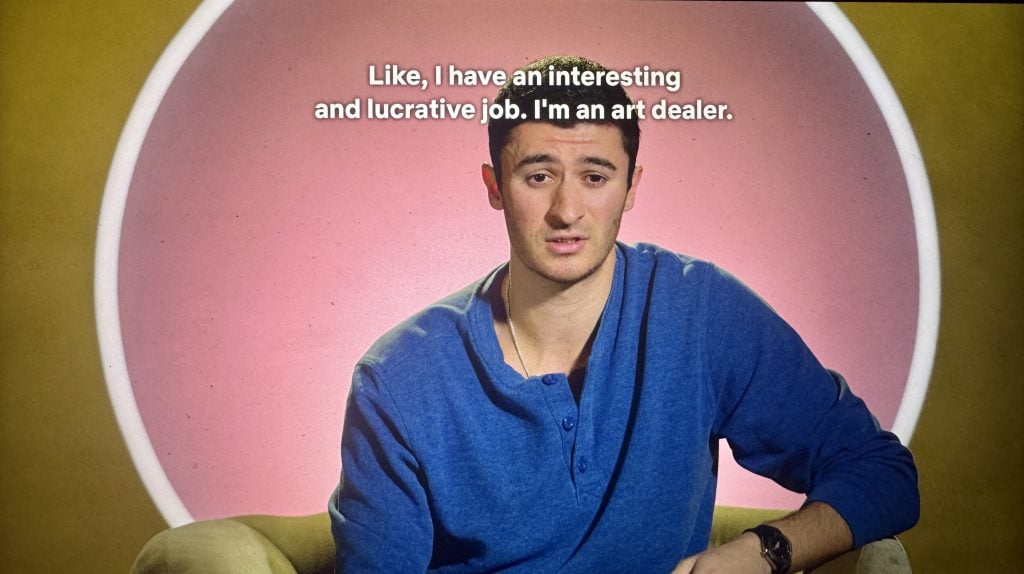Pop Culture
‘Love Is Blind’ Villain Leo Braudy on His Life as an Art Dealer
“I was learning Italian art terminology when I was like, six."

“I was learning Italian art terminology when I was like, six."

Annie Armstrong

Crossovers between the art world and reality television are rare (but not unheard of!). Earlier this month, the cult favorite Netflix series Love Is Blind premiered its seventh season, and an early pick for best villain is Leo Braudy, who comes in hot within the first 15 minutes of the season-opener declaring, “I have an interesting and lucrative job; I’m an art dealer.”
Braudy, who is 30, quickly became one of the more contentious characters on a show that is designed for people with big personalities. (Contestants are held in separate rooms to interview potential suitors without judging them by looks.) Another choice quote: “I’m not trying to build an influencer career. I’m a rich fucking art dealer.” Also: “I was learning Italian art terminology when I was like, six. For example, I’ll give you one: sprezzatura.”
So what’s the deal? Curious about his life as an art dealer, I got in touch with Braudy. Below is an edited version of our conversation.
So tell me about your art-dealing career. How did you get started?
My family’s been in the business for a few generations. My grandparents Ethel and Arthur Furman started dealing back in the 1970 in the Washington, D.C., area. I’ve been involved since childhood. I remember my first task was sitting with my grandpa, transcribing client emails for him because I could type faster than his two finger “bird peck” method.
After I graduated college in 2015, I joined the business full-time with the expectation I would gradually take it over in a few decades. But I ended up inheriting the business a lot sooner than expected when my grandpa, grandma, and mom passed away—all from cancer—between 2018 and 2021. While the transition was incredibly difficult (the “dark years” as I call them), their passion for the arts lives on through me.
What kind of artwork do you specialize in, if you do?
My family started in decorative sculpture with an initial emphasis in contemporary studio glass art (like Dale Chihuly and Lino Tagliapietra) and decorative bronzes. Over the decades we have since expanded into Modern and contemporary paintings and sculpture, and still deal decorative as well. We deal in a mixture of primary and secondary markets.

The LinkedIn headshot of Leo Braudy, the boastful art dealer on Netflix’s “Love is Blind.” Courtesy of Leo Braudy.
What do you love about art? How did you originally get involved?
I love art’s ability to spark a conversation. There is value in absorbing art in silence and solitude, but I’m also a pretty extroverted guy, and I want to talk about it! I think some people feel they need to be hushy-hushy when discussing art. You’ll often find me animated and colloquial. Connoisseur-speak has its place, but there’s also nothing wrong with saying, “Dude, that painting is sick!”
My family did a great job of instilling within me a passion for art and understanding art markets. They used to take me around our showroom and have me memorize the artists, works, and price ranges. They’d give me a few bucks or candy if I got everything right. They always made it a game, which was really smart, looking back.
What is the best museum show you’ve ever seen?
I think my favorite museum show of the past few years was the traveling show “Philip Guston Now” exhibition, which I saw at the National Gallery of Art [in D.C.] in 2023. I was blown away with the variety in Guston’s oeuvre. If there were no labels, I would’ve thought there were a dozen different artists, each of them masters in their own right. It was also spectacularly curated by the brilliant Harry Cooper; he used every nook and cranny of NGA’s East Wing space. I must have spent five hours there.
It was cool to see an art dealer on such a mainstream TV show. What do you think is the common perception of art dealers to people who don’t work in the art industry?
Quite frankly, I don’t know if our image outside the art world is all that positive. I think we can be portrayed as cold, stuffy, or disconnected. Or even worse, legal money launderers! I think we could do a better job advocating for ourselves and being more open and transparent about what we do. Most of us are just art nerds who want an excuse to be around art all day.
From your perspective, what is the best part of being an art dealer?
For me, it’s getting to know the artists. They often challenge me to see the world in new ways. When I’m with an artist, I never know what’s going to happen next. When I was a teenager, my family and I were having dinner with the late Marvin Lipofsky. The waiter brought Marvin out a side of mashed potatoes, and Marvin (with a spoon) sculpted into his mashed potatoes a pair of lips. And then he kissed it.